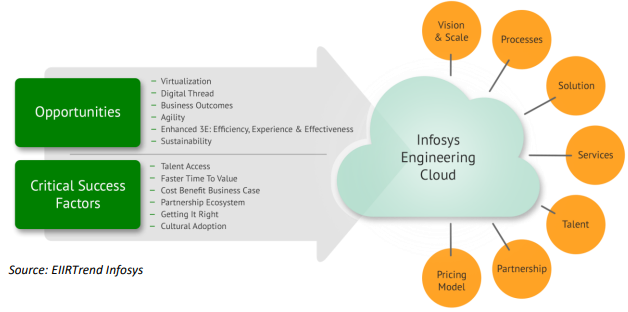The engineering cloud is an emerging trend across engineering enterprises. As enterprises embrace virtualization and cloud-enabled digital transformation, they also have an opportunity to transform the performance of their engineering operations with the engineering cloud. The engineering cloud (meaning cloud for engineering functions/solutions/products/processes) is different from cloud engineering, which pertains to the engineering of the cloud infrastructure and tech stack. This PoV defines the engineering cloud and discusses its significance for enterprises and the success factors for implementation. It also discusses Infosys’ comprehensive approach to the engineering cloud driven by its Cobalt suite of services, solutions, platforms, tools, and knowledge artifacts.
Link : Download

Defining the Engineering Cloud
Abhishek believes that Enterprises are looking at Cloud coupled with other digital technologies like AR/VR/AI/ML/Autonomous, not just for enabling their IT Operations but even for orchestrating their Core Engineering Functions like Design, PLM, Manufacturing, Networking both at a product and process level. This will be the new frontier for accelerating Engineering and R&D. Thus cloud is an enabler in transforming engineering products, processes, and business models.
“The engineering cloud is defined as all engineering activities on the cloud that help to connect engineering products, optimize engineering processes, and servitize engineering business models.”
- Abhishek Goyal, VP Engineering and IOT at Infosys.
The engineering cloud is different from cloud engineering, as shown in the exhibit below

Importance of Engineering Cloud Important and Why Now? (h2)
The engineering cloud creates an environment for enterprises to transform and thrive. Six specific value propositions of the engineering cloud are:
Virtualization: The cloud enables physical processes to perform virtually. It is especially important when physical access or collaboration is not possible. It also helps reduce cost and time. Even if the whole process cannot be performed virtually, some degree of virtualization helps in better process performance and management.
In engineering, processes such as design and testing can be done on the engineering cloud. Even some activities in manufacturing, operations, and after-sales can be improved on the engineering cloud.
Example: Core engineering applications in the design phase around CAE, CAD, and CAX including compute-heavy applications like simulations are being hosted on a virtualized environment either in enterprise data centers or the public cloud. This provides flexibility of scale as you grow and high availability of more clusters for those critical applications. Also, it is easy to deploy and manage.
Digital Engineering or Digital Thread: The engineering cloud can help to transform engineering enterprises digitally like digital natives. Times are changing, and processes need to be transformed along with the changing times and emerging technologies.
A procurement process that relies on historical data to plan orders should be digitally transformed to track real-time equipment failures using IoT and analytics, and then plan orders. Similarly, many processes can be improved by leveraging AI, automation, and analytics. Products can be transformed by making them connected.
Business models can be transformed by servitization and closed-loop product lifecycle. All these and many more capabilities are possible on the engineering cloud. Manufacturing and engineering applications on the cloud enable collaborative design with distributed teams and remote operations of production and operations. The full potential of digital transformation will be realized when enterprises move the bulk of their engineering processes and applications to the cloud, make their products connected, and leverage new business models.
Example: A large industrial motor manufacturing client transformed its manufacturing process from Engineered to Order (ETO) to Configured to Order (CTO). This shift was made possible by integrated data from design, engineering, and manufacturing and then to service. Setting this up on the cloud enabled faster collaboration, which in turn, enabled a responsive supply chain by connecting engineering data with the suppliers in real-time.
Business Outcomes: Achieving a step-change in business performance in efficiency, growth, productivity, quality, and flexibility for an engineering enterprise is possible with the engineering cloud.
Some of the business outcomes are productivity and cost improvement, reduction in product and services cost, reduction in wastage, reduction in time to market, traceability, and reduction in time to quote. The engineering cloud enables smart connected products and smart connected services leading to an as-a-service model of product offering.
Example: A large industrial equipment manufacturer designed smart connected forklifts. This has enabled the client to monitor the usage and the condition of the forklifts remotely in real time 24X7. It is helping the client improve utilization, reduce downtime, and improve MTTR and MTBF.
Agility: It involves making engineering organizations agile with lean and digital engineering processes so they can capitalize on opportunities much faster and be able to respond effectively to disruption and challenges. As we have seen in the pandemic, disruptions can come from anywhere, and enterprises that are agile and can respond to disruptions survive.
Also, rapid innovation is required to win in a hypercompetitive market. The engineering cloud helps develop a flexible technical stack for the enterprise, which enables rapid change and experimentation. This flexibility enables an engineering organization to design and deliver quickly, efficiently, and effectively.
Example: A digital supply chain enabled through cloud-based collaboration platforms connecting all the key suppliers helped improve responsiveness and reduced sourcing lead times. It also helped build resiliency in the pandemic by rerouting supplies.
Enhanced 3E – Efficiency, Experience, and Effectiveness: Digital engineering improves the visibility of information with data. When enhanced with AI and ML, the bottlenecks in the system—process or machines—are visible. This helps improve efficiency across the process.
The responsiveness of the whole system is improved due to real-time data-driven insights and actions. Right first-time responses improve. Finally, with persona-based and experience-based design, the overall experience of every persona is addressed.
Example: Manufacturing organizations use machine data to monitor the condition and state of the machine to bring in predictive maintenance. Use the machine-state data to predict the impact on product quality. Having the right information relevant to the person whether it is the operator, technician, supervisor, or supplier improves the work experience.
Sustainability: With circular economy concepts, the design of the products now has to consider the end of life and disposal of the product for sustainability. Manufacturing and engineering organizations are measuring the energy consumed per product and the waste generated per product. These KPIs are becoming the corporate mandate and are appearing as disclosures in the financial reports.
With cloud engineering and digital thread, product life cycle process handling becomes simplified as the data is integrated on a common platform, and through the cloud, it is visible to all the stakeholders. The engineering cloud journey also helps enterprises in their sustainability outcomes and their net-zero pledges to obtain measurable savings in energy.
Example: A power generation company developed a real-time monitoring solution to manage hazardous material handling and dispatching. With real-time visibility on the cloud, tracking and tracing of the material throughout the life cycle ensured compliance with the process.
Now, after the pandemic, there is a greater push on all the above. Enterprises want capabilities to operate virtually if needed. Engineering enterprises are adopting agile product engineering to respond faster to the customer and the market demand of customized products and reduce time to market of new products. To survive competition, enterprises need to transform, become more agile, and deliver business outcomes. Enterprises also need to work on efficiency, experience, effectiveness, and sustainability.





 Pareekh Jain
Founder of Pareekh Consulting & EIIRTrends
Pareekh Jain
Founder of Pareekh Consulting & EIIRTrends